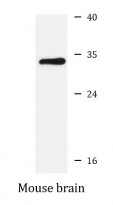ARG57617
anti-SLC25A14 antibody
anti-SLC25A14 antibody for Western blot and Mouse,Rat
Overview
| Product Description | Rabbit Polyclonal antibody recognizes SLC25A14 |
|---|---|
| Tested Reactivity | Ms, Rat |
| Tested Application | WB |
| Host | Rabbit |
| Clonality | Polyclonal |
| Isotype | IgG |
| Target Name | SLC25A14 |
| Antigen Species | Human |
| Immunogen | Recombinant protein of Human SLC25A14. |
| Conjugation | Un-conjugated |
| Alternate Names | Mitochondrial uncoupling protein 5; Brain mitochondrial carrier protein 1; Solute carrier family 25 member 14; UCP 5; BMCP1; BMCP-1; UCP5 |
Application Instructions
| Application Suggestion |
|
||||
|---|---|---|---|---|---|
| Application Note | * The dilutions indicate recommended starting dilutions and the optimal dilutions or concentrations should be determined by the scientist. | ||||
| Positive Control | Mouse brain | ||||
| Observed Size | 36 kDa |
Properties
| Form | Liquid |
|---|---|
| Purification | Affinity purified. |
| Buffer | PBS (pH 7.3), 0.02% Sodium azide and 50% Glycerol. |
| Preservative | 0.02% Sodium azide |
| Stabilizer | 50% Glycerol |
| Storage Instruction | For continuous use, store undiluted antibody at 2-8°C for up to a week. For long-term storage, aliquot and store at -20°C. Storage in frost free freezers is not recommended. Avoid repeated freeze/thaw cycles. Suggest spin the vial prior to opening. The antibody solution should be gently mixed before use. |
| Note | For laboratory research only, not for drug, diagnostic or other use. |
Bioinformation
| Database Links |
Swiss-port # Q9Z2B2 Mouse Brain mitochondrial carrier protein 1 |
|---|---|
| Gene Symbol | SLC25A14 |
| Gene Full Name | solute carrier family 25 (mitochondrial carrier, brain), member 14 |
| Background | Mitochondrial uncoupling proteins (UCP) are members of the larger family of mitochondrial anion carrier proteins (MACP). Uncoupling proteins separate oxidative phosphorylation from ATP synthesis with energy dissipated as heat, also referred to as the mitochondrial proton leak. Uncoupling proteins facilitate the transfer of anions from the inner to the outer mitochondrial membrane and the return transfer of protons from the outer to the inner mitochondrial membrane. They also reduce the mitochondrial membrane potential in mammalian cells. This gene is widely expressed in many tissues with the greatest abundance in brain and testis. Alternative splicing results in multiple transcript variants. A pseudogene of this gene has been defined on chromosome 4. [provided by RefSeq, Aug 2013] |
| Function | Participates in the mitochondrial proton leak measured in brain mitochondria. [UniProt] |
| Calculated MW | 36 kDa |
Images (1) Click the Picture to Zoom In






